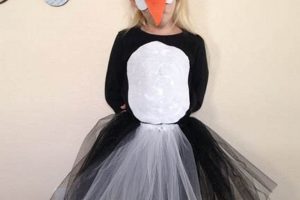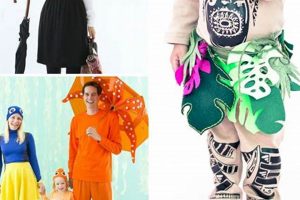The crafting of individualized domestic servant attire represents an approach to costuming that emphasizes personalization and resourcefulness. This practice involves creating an outfit inspired by traditional maid uniforms, often utilizing existing clothing items and readily available materials. The result is a unique ensemble tailored to individual preferences, potentially diverging significantly from commercially available options.
The appeal of constructing such a garment lies in its affordability, adaptability, and potential for creative expression. It allows individuals to bypass the limitations of standardized sizes and pre-designed aesthetics, fostering a sense of originality. Historically, domestic worker uniforms served as indicators of social status and occupational role; the modern interpretation through self-assembly repurposes this imagery, offering a commentary on both tradition and individual empowerment. The activity promotes the application of practical skills, encouraging resourcefulness and imaginative design.
The following sections will explore specific techniques for achieving a bespoke outcome, including fabric selection, pattern adaptation, and embellishment strategies. These topics will provide a practical guide for those interested in pursuing this project, emphasizing both functionality and aesthetic considerations.
DIY Maid Costume
The creation of a distinctive domestic servant-inspired outfit requires careful attention to detail and a strategic approach. The following guidelines address key aspects of construction and design, ensuring a polished and effective final product.
Tip 1: Fabric Selection: Prioritize durable, easy-to-clean materials such as cotton blends or polyester. These fabrics withstand wear and tear and facilitate maintenance, critical for a convincing appearance. Consider the drape and texture of the fabric to achieve the desired silhouette. For instance, a crisp cotton poplin will create a more structured look, while a softer twill will offer a more relaxed feel.
Tip 2: Pattern Adaptation: If a commercial pattern is employed, modify it to reflect the intended design. Pay close attention to neckline, sleeve length, and skirt fullness. Elements such as Peter Pan collars or puff sleeves can enhance the recognizable aesthetic. Consider using a basic bodice pattern as a foundation and altering it to incorporate design-specific features.
Tip 3: Strategic Embellishment: Lace trim, ribbon, and buttons are valuable for adding visual interest. Employ these embellishments sparingly and with intention. Avoid excessive ornamentation that detracts from the overall design. Placement should be deliberate, such as along the collar, cuffs, or apron edges.
Tip 4: Apron Construction: The apron is a defining element. Consider its size, shape, and attachment method. A bib apron offers full coverage, while a waist apron provides a more minimalist look. Ensure the apron straps are securely attached and comfortably adjustable.
Tip 5: Headwear Options: Headwear contributes significantly to the visual impact. A traditional lace cap, a simple headband, or a decorative hair bow can all serve as suitable complements. Match the headwear to the overall aesthetic, ensuring it harmonizes with the garment’s style and color palette.
Tip 6: Attention to Detail: Seam finishes, closures, and overall construction quality matter. Invest time in proper stitching, pressing, and finishing. A well-constructed garment conveys a sense of professionalism, even in a costume context. Utilize techniques such as French seams or serged edges to prevent fraying and enhance durability.
Tip 7: Proportional Considerations: Maintain consistent proportions throughout the design. Ensure that the size of the apron, headwear, and embellishments are appropriately scaled to the overall garment and the wearer’s body type. A disproportionate element can disrupt the visual harmony of the ensemble.
Effective execution hinges on careful planning, precise construction, and a discerning eye for detail. By adhering to these guidelines, the resulting garment will be both aesthetically pleasing and structurally sound.
The following section will explore methods for refining the finished product, focusing on accessory selection and presentation techniques.
1. Fabric Selection
Fabric selection constitutes a foundational element in the creation of personalized domestic servant-inspired attire. The properties of chosen materials directly influence the garment’s aesthetic appeal, functionality, and longevity. Thoughtful consideration of these factors is paramount to achieving a successful outcome.
- Durability and Maintenance
The intended use and frequency of wear necessitate a durable and easily maintained fabric. Cotton blends, polyester, and linen offer varying degrees of resistance to wear and tear. Costumes subject to frequent laundering benefit from fabrics that retain their integrity and color after repeated washings. Failure to consider durability can result in premature degradation and a diminished aesthetic appeal. Examples include using a heavy-weight twill versus a delicate voile.
- Aesthetic Authenticity
The selection of fabrics that align with historical or stylistic precedents enhances the costume’s authenticity. Historically, domestic uniforms often incorporated practical materials such as cotton or linen. Replicating these choices can contribute to a more convincing representation. Deviations from these norms, employing modern synthetic materials, may offer practical advantages but could compromise the overall aesthetic integrity. Examples include broadcloth or poplin for a crisp, traditional look.
- Comfort and Breathability
Comfort is a significant factor, particularly for costumes intended for extended wear. Natural fibers, such as cotton and linen, exhibit superior breathability compared to synthetics. Adequate airflow prevents overheating and enhances the wearer’s overall comfort. Conversely, tightly woven synthetic fabrics can restrict airflow, leading to discomfort and potential irritation. Examples include prioritizing cotton for a costume worn in a warm climate.
- Cost and Accessibility
Budget constraints and material availability inevitably influence the selection process. Cost-effective alternatives, such as repurposed fabrics or discounted remnants, can provide viable options without compromising the overall design. However, compromises in fabric quality may impact the garment’s durability and aesthetic appeal. Balancing cost considerations with desired material properties is a crucial aspect of the decision-making process. Examples include sourcing fabric from thrift stores versus specialty fabric retailers.
The multifaceted relationship between fabric choice and the final product highlights the importance of careful consideration. The selection of appropriate materials dictates not only the aesthetic outcome but also the costume’s functionality and longevity. A well-informed decision in this regard s
ignificantly contributes to the overall success of the creation.
2. Pattern modification
Pattern modification represents a crucial step in crafting personalized domestic servant-inspired attire. Commercial patterns rarely align precisely with individual preferences or body measurements, thus necessitating adjustments to achieve a satisfactory fit and desired aesthetic.
- Sizing Adjustments
Commercial patterns adhere to standardized sizing, which may not accurately reflect individual body proportions. Adjustments for bust, waist, and hip measurements are often required to ensure a garment that fits comfortably and flatters the wearer. Failure to address sizing discrepancies can result in a costume that is either too tight, too loose, or otherwise ill-fitting, detracting from its overall appearance.
- Style Adaptations
Existing patterns can be modified to incorporate specific stylistic elements characteristic of domestic servant uniforms. Examples include altering neckline shapes, adding or removing sleeves, or adjusting skirt lengths. These adaptations allow for a more historically accurate or personalized interpretation of the costume. Consideration must be given to maintaining the garment’s structural integrity during these modifications. For instance, altering a neckline may necessitate adjustments to the shoulder seams or facing pattern pieces.
- Apron Integration
Domestic servant attire frequently incorporates an apron as a defining element. Patterns for aprons can be drafted from scratch or adapted from existing apron patterns. The apron’s size, shape, and attachment method significantly impact the overall design. Adjustments to the bodice pattern may be necessary to accommodate the apron straps or ties. Furthermore, the placement and style of pockets on the apron can be customized through pattern modification.
- Embellishment Accommodation
Pattern modification can facilitate the addition of embellishments such as lace, ruffles, or pleats. Altering seam allowances or adding extra fabric panels allows for the incorporation of these decorative elements. Strategic planning is essential to ensure that embellishments are appropriately positioned and securely attached to the garment. Moreover, adjustments to the pattern may be required to compensate for the bulk or stiffness introduced by certain embellishments.
In conclusion, pattern modification provides the means to transform a generic template into a bespoke representation of domestic servant-inspired attire. Skillful application of these techniques ensures a garment that not only fits well but also accurately reflects the desired aesthetic and incorporates personalized design elements. The precision and thoughtfulness invested in pattern adjustments ultimately contribute to the overall success of the finished costume.
3. Apron design
Apron design represents a defining element within the context of crafting domestic servant-inspired attire. It significantly influences the overall aesthetic, functionality, and historical accuracy of the ensemble.
- Material Selection and Durability
The choice of fabric for the apron dictates its durability, cleanability, and visual texture. Sturdy, washable materials such as cotton or linen blends are common choices. The apron’s material must withstand frequent use and potential staining. For example, a heavy-duty cotton canvas offers greater protection than a delicate lace fabric, impacting the overall practicality of the garment.
- Style and Coverage
Apron styles vary, ranging from full-coverage bib aprons to simpler waist aprons. The chosen style impacts the level of protection afforded to the underlying garment and contributes to the overall visual impression. A bib apron provides more comprehensive coverage, aligning with traditional depictions of domestic work. A waist apron offers a more minimalist aesthetic, potentially prioritizing style over practicality. The choice influences the costume’s perceived authenticity and functional utility.
- Fastening and Adjustability
The fastening method, whether ties, buttons, or snaps, affects the apron’s adjustability and ease of use. Adjustable ties allow for a customized fit, accommodating varying body sizes and shapes. Secure and easily manipulated fastenings enhance the apron’s functionality, enabling quick removal or adjustment as needed. A poorly designed fastening system can compromise the apron’s stability and user convenience.
- Embellishment and Detailing
Embellishments such as lace, ruffles, pockets, and embroidery contribute to the apron’s visual character and can enhance its practical utility. Lace and ruffles add a decorative element, potentially reflecting a more stylized or theatrical interpretation. Pockets provide convenient storage for small items, increasing the apron’s functional value. The strategic use of embellishments can elevate the apron from a purely utilitarian garment to a focal point of the costume.
The integration of these apron design elements directly shapes the effectiveness of the overall domestic servant-inspired ensemble. Thoughtful consideration of material, style, fastening, and embellishment ensures that the apron serves as both a functional and visually compelling component of the homemade attire.
4. Embellishment choices
The selection of embellishments constitutes a critical decision-making juncture in the creation of customized domestic servant-inspired attire. These choices significantly influence the aesthetic interpretation, ranging from historical accuracy to theatrical exaggeration. Prudent selection and application can elevate a simple garment into a compelling representation.
- Lace Application and Style
Lace trim serves as a common embellishment, adding visual texture and a sense of delicate refinement. The style of lace, whether a simple edging or an elaborate insertion, significantly impacts the garment’s overall aesthetic. For historical interpretations, cotton or linen lace is often preferred, while synthetic options offer greater durability and affordability. The quantity and placement of lace should be carefully considered to avoid overwhelming the design. For example, a narrow lace edging along the collar and cuffs of an apron provides a subtle accent, whereas excessive lace can detract from the garment’s functionality.
- Ribbon Selection and Placement
Ribbon provides a versatile embellishment option, offering opportunities to introduce color and visual interest. The choice of ribbon material, width, and color should complement the primary fabric of the garment. Ribbon can be used for decorative bows, ties, or as edging along hems and seams. Strategic placement of ribbon can emphasize specific features, such as the waistline or neckline. For instance, a contrasting ribbon tied around the waist of an apron accentuates the garment’s shape and adds a pop of color. The choice of ribbon, satin or grosgrain, affects the light refraction of the diy
maid costume. - Button Selection and Functionality
Buttons serve both functional and decorative purposes. The style of button, whether a simple pearl button or an ornate metal button, contributes to the overall aesthetic. Button placement should align with the garment’s construction and intended function. Buttons can be used as closures for bodices, cuffs, or aprons, or as purely decorative elements. The size and spacing of buttons should be carefully considered to ensure proper closure and visual balance. Incorrectly sized buttons that do not fit the buttonholes will render the garment unwearable.
- Ruffles and Pleats Incorporation
Ruffles and pleats offer opportunities to add volume and visual texture. Ruffles can be created from self-fabric or contrasting materials and attached to edges, cuffs, or collars. Pleats provide a more structured form of embellishment, adding dimension and shape to the garment. The size, spacing, and orientation of ruffles and pleats should be carefully considered to achieve the desired effect. Overly large or poorly placed ruffles can appear bulky and unflattering. The choice to incorporate ruffles needs to be considered at pattern modification stage of diy maid costume.
The strategic application of embellishments transforms a basic foundation into a uniquely expressive piece. Through thoughtful consideration of lace, ribbon, buttons, ruffles, and other decorative elements, individualized domestic servant-inspired attire can achieve both visual appeal and a personalized aesthetic.
5. Headwear options
Headwear constitutes an integral component in completing domestic servant-inspired attire. Its selection significantly impacts the overall visual impact and historical accuracy of the homemade costume. The following explores various headwear options within the context of a “diy maid costume”, outlining their characteristics and implications.
- Lace Cap Construction and Design
The traditional lace cap, often constructed from cotton or synthetic lace, represents a historically prevalent headwear choice. Its design typically involves a gathered or pleated lace edging attached to a simple cap base. The size, shape, and detailing of the lace cap can vary, influencing the costume’s perceived formality. A larger, more elaborate lace cap imparts a more formal impression, while a smaller, simpler cap suggests a more practical or utilitarian aesthetic. Construction can involve hand-sewing or machine-sewing techniques, impacting the final product’s precision and durability. The cap design contributes significantly to the diy maid costumes authenticity.
- Headband Variations and Customization
Headbands offer a more modern and adaptable alternative to traditional lace caps. They can be constructed from a variety of materials, including fabric, ribbon, or elastic. Headbands can be embellished with bows, flowers, or other decorative elements to enhance their visual appeal. The versatility of headbands allows for greater customization and personalization, enabling integration with diverse costume styles. A simple black headband can provide a subtle and understated accent, while a more elaborate headband with embellishments can create a more theatrical effect. The diy maid costume benefits from the adaptable nature of the headband.
- Hair Ribbon Integration and Styling
Hair ribbons offer a simple and cost-effective method for completing the ensemble. Ribbons can be tied around the hair in various styles, such as bows, braids, or ponytails. The choice of ribbon color and material can complement the overall color scheme and aesthetic of the costume. Ribbons provide a subtle yet effective means of adding visual interest and reinforcing the chosen theme. Using a simple white ribbon is a simple embellishment of diy maid costume.
- Bonnet Adaptation and Thematic Consistency
Bonnet adaptation allows for an expanded set of options in completing a diy maid costume. This offers a thematic alternative in headwear choice. The user should select an appropriate style of bonnet to maintain an air of authenticity. This will depend on the era or the reference point of the costume.
The ultimate selection of headwear must correlate with the specific design and intended aesthetic of the homemade domestic servant-inspired garment. Whether through the utilization of traditional lace caps, adaptable headbands, simple hair ribbons, or the bonnet, attention to detail is crucial to achieving a cohesive and visually compelling result. The culmination of these elements contributes significantly to the overall success of the “diy maid costume”.
6. Fit and comfort
The successful execution of personalized domestic servant-inspired attire hinges significantly on the integration of optimal fit and sustained comfort. These parameters dictate the wearer’s ability to engage with the costume effectively and are, therefore, critical considerations throughout the construction process.
- Garment Mobility and Range of Motion
Appropriate fit ensures unencumbered movement, allowing the wearer to perform intended actions without restriction. A garment that is too tight across the shoulders, chest, or hips limits mobility and can cause discomfort or even injury. Conversely, excessively loose garments can pose a tripping hazard and detract from the overall aesthetic. Pattern alterations and careful measurements are essential to achieving a fit that balances both form and function. Examples include ensuring sufficient ease in the armscye for comfortable arm movement and allowing enough room in the skirt for walking and bending.
- Fabric Breathability and Temperature Regulation
Fabric selection plays a crucial role in maintaining comfort, particularly during extended wear. Natural fibers, such as cotton and linen, promote breathability, allowing air to circulate and preventing overheating. Synthetic fabrics, while potentially more durable or wrinkle-resistant, can trap heat and moisture, leading to discomfort. The layering of garments should also be considered to allow for adjustments based on environmental conditions. Examples include choosing a lightweight cotton blend for costumes intended for warm weather and incorporating breathable lining materials to enhance comfort.
- Seam Placement and Abrasion Reduction
Strategic seam placement minimizes the potential for abrasion and irritation. Seams positioned in high-friction areas, such as under the arms or along the inner thighs, can cause chafing and discomfort. Utilizing flat-felled seams or serged edges reduces bulk and prevents fraying, further enhancing comfort. Careful attention to detail during construction ensures that seams are smooth and unobtrusive. Examples include relocating side seams to avoid pressure points and using soft, flexible thread to minimize irritation.
- Undergarment Compatibility and Support
The choice of undergarments significantly impacts the overall fit and comfort of the costume. Supportive undergarments can enhance the silhouette and provide additional comfort, particularly for costumes that require specific shaping or support. Seamless or moisture-wicking undergarments minimize the potential for irritation and chafing. Examples include selecting a support
ive corset or bustier to achieve a desired waistline and using seamless underwear to prevent visible panty lines and enhance comfort.
The confluence of these factors directly influences the success of creating personalized domestic servant-inspired attire. A well-fitted and comfortable garment allows the wearer to fully engage with the costume, enhancing both its aesthetic impact and overall enjoyment. Prioritizing fit and comfort throughout the design and construction process ensures a garment that is not only visually appealing but also practical and enjoyable to wear.
7. Durability/Washability
The inherent connection between durability/washability and the construction of individualized domestic servant-inspired attire is critical, influencing both the longevity and practicality of the finished product. The intended usage context, often involving repeated wear and potential exposure to staining agents, necessitates careful consideration of these factors during the design and material selection phases. Compromising on durability/washability results in a garment with a limited lifespan, demanding frequent repairs or replacement, thereby negating the cost-effectiveness typically associated with do-it-yourself projects. Examples include the selection of delicate fabrics prone to tearing or the use of dyes susceptible to fading after multiple wash cycles, both of which diminish the garment’s utility.
Furthermore, the practical application of such attire often involves environments where spills and stains are common. A fabric that is easily cleaned and resistant to damage from common cleaning agents is essential. This directly impacts the garment’s ability to maintain its visual appeal over time. For instance, a cotton-polyester blend offers a superior balance of durability and washability compared to pure cotton, resisting wrinkles and stains more effectively. The choice of embellishments, such as lace or trim, must also consider washability; delicate trims may require handwashing or specialized cleaning, adding to the maintenance burden. The garment’s long-term viability hinges on the ability to withstand regular laundering without significant degradation.
In conclusion, neglecting the critical aspects of durability and washability compromises the core value proposition of a self-constructed garment. Prioritizing robust materials, colorfast dyes, and construction techniques that enhance resistance to wear and tear is paramount. This proactive approach ensures that the completed domestic servant-inspired attire remains both aesthetically pleasing and functionally viable over an extended period, maximizing the investment of time and resources. The long-term success of a diy maid costume is inextricably linked to its ability to withstand the rigors of repeated use and cleaning.
Frequently Asked Questions
The following addresses common inquiries regarding the creation of customized domestic servant-inspired attire. The information presented aims to provide clarity and guidance for individuals undertaking such projects.
Question 1: What fabric types are most suitable for homemade domestic servant outfits?
Durable, easy-to-clean fabrics such as cotton blends, linen, and polyester are recommended. These materials offer a balance of comfort, longevity, and affordability. Avoid delicate fabrics prone to tearing or requiring specialized cleaning.
Question 2: How can commercial patterns be effectively modified to achieve a historically accurate aesthetic?
Examine historical sources for design cues. Adjust neckline shapes, sleeve lengths, and skirt fullness to align with period-appropriate styles. Consider adding details such as aprons, collars, and cuffs that reflect the intended era.
Question 3: What considerations should guide the design of the apron, a defining element of this attire?
Apron design should reflect the desired level of formality and functionality. Bib aprons provide greater coverage, while waist aprons offer a more minimalist aesthetic. Fabric choice, strap construction, and embellishment should complement the overall design.
Question 4: How can embellishments, such as lace and ruffles, be effectively incorporated without overwhelming the design?
Employ embellishments strategically and sparingly. Consider the scale and placement of lace, ruffles, and other decorative elements. Avoid excessive ornamentation that detracts from the garment’s functionality or historical accuracy.
Question 5: What headwear options are appropriate for homemade domestic servant-inspired attire?
Traditional lace caps, headbands, and hair ribbons all serve as suitable complements. Select headwear that harmonizes with the garment’s style and color palette. Ensure that the chosen headwear remains secure and comfortable throughout wear.
Question 6: How can proper fit and comfort be ensured when constructing this type of attire?
Take accurate measurements and adjust patterns accordingly. Prioritize fabrics that promote breathability and allow for ease of movement. Pay attention to seam placement to minimize abrasion and irritation. Undergarments should be supportive and comfortable.
In summary, successful creation hinges on careful planning, precise execution, and a discerning eye for detail. Attention to fabric selection, pattern modification, embellishment, and fit ensures a garment that is both aesthetically pleasing and structurally sound.
The concluding section will synthesize the key principles outlined, providing a consolidated guide to successful garment creation.
DIY Maid Costume
This exploration has detailed the essential considerations in creating individualized domestic servant-inspired attire, often referenced as a “diy maid costume.” Key aspects include fabric selection, pattern modification, strategic embellishment, and a commitment to both durability and wearer comfort. Each element contributes to the successful realization of a garment that balances aesthetic appeal with practical functionality, departing from standardized commercial offerings. This project emphasizes resourcefulness and personalized creative expression within the defined constraints of the theme.
The endeavor to craft such a garment presents both opportunities and challenges. Success requires a careful synthesis of technical skill, historical awareness, and individual artistic vision. The pursuit of this project is encouraged for those seeking to engage in a creative and resourceful endeavor, yielding a tangible and expressive outcome. Further exploration of historical costuming techniques and advanced sewing methods is recommended to enhance the quality and authenticity of future creations.







